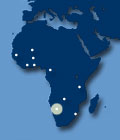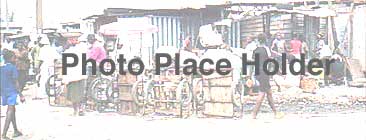|
||||||||||||
| Burkina Faso | Cameroon | Cote D’Ivoire | Ghana | Mali | Namibia | Senegal | Swaziland | Tanzania | Zambia | ||||||||||||
Information Source: Namibia: Country Assessment Report. |
||||||||||||
|
||||||||||||
|
Context Summary Namibia is a large country of approximately 824,000 sq. km, with a small population of 1.7 million in 1999. It is rich in minerals and exports include diamonds, copper, gold, zinc, lead, uranium, cattle and processed fish. The Gross Domestic Product per capita is approximately US$2,000 (1998). Namibia is characterized by three physical regions: a low lying coastal belt largely made up by the Namib desert along the western Atlantic coast; a central plateau averaging about 1,100 meters in elevation; and, the Kalahari desert along the eastern border. Apart from four permanent rivers there is virtually no other surface water. The climate is generally hot and dry and availability of freshwater is a major problem. There are two major urban areas: the capital city, Windhoek (approx. 235,000 population), and the center of the fishing industry Walvis Bay (60,000 pop.) located on the skeleton coast. With a third, Swakopmund (15,000 pop), they together make up over 70 percent of the country’s urban population which accounts for about 33 percent of the country’s total population. Based on 1995 projections Windhoek’s population will reach 420,000 by year 2010. The accelerated influx of migrants into Windhoek after 1991 after independence caused progressive settlement growth on council-owned land as well as considerable shelter and servicing problems. In 2001 almost 30 percent of the population living in Windhoek (including nearby Katatura) live in informal, unplanned communities, in sub-standard structures on un-surveyed land without legal title. Most informal areas have access to safe water, communal taps are within considerable walking distance but fewer than 20 percent of the households are connected to a waterborne sewerage network. Private and public sector developers (e.g., National Housing Enterprise) provide limited housing available only to the middle and upper-income households. An “in-situ upgrading” initiative honors the natural settlement patterns and densities that had developed. Concepts of communal block tenure and shared communal service facilities are used and welcomed by the communities. Lessons from Recent Projects - Summary Affordability
Harmonization of National and Local Housing and Related Policies Policies and resulting programs should be tested and not hampered by overly prescriptive national policies, which cover some issues that would be better decided by local stakeholders, especially communities. 'Erf' Sizes, Densities and Costs More efficient use of land and development funds (for servicing) would be achieved with higher densities than the 113 persons/ha now. Smaller 'erf' sizes and road reserves of lesser width may be considered. Upgrading and its Costs Costs of upgrading at various development levels added to the "Service Standards and Development Levels Matrix" allow early meaningful dialogue with communities on trade–offs between development levels, costs and affordability. Upgrading of Blocks Upgrading of blocks within settlements should be tried. Several questions arise, such as, who pays for infrastructure not required directly by the block but required for the block infrastructure to be able to operate (i.e., the upstream or downstream infrastructure)? Leasing and Loans for Purchase Selling serviced 'erven' (with the selling price covering the cost of servicing) is encouraged, as well as arrangements (leasing) for those unable to purchase. It is unclear whether a financial intermediary (e.g., Building Society) to provide finance for purchase (and lease) or whether the Council is to provide such finance and is to continue with rental housing. Private financial sector involvement of upgrading initiatives should be considered. Implementation Test the process as quickly as possible, to learn and to modify strategy elements if necessary based on implementation results. Subsidy Funding upgrading schemes if no subsidies are forthcoming from central Government is a serious issue, as is the issue of subsidies providing a disincentive to people to help themselves. |
||||||||||||
|
|
||||||||||||
| For more information: Click on: Foreword 1. Background 2. Current Situation 3. Policy Context and Institutional Framework 4. Upgrading Projects and Programs 5. Case Study 6. Lessons Learned 7. Challenges and Proposed Next Steps Annex A: Country and City Data Annex B: Bibliography Annex C: Contact Information Annex D: Land Needs and Constraints Annex E: Upgrading Programs/Projects Annex F: Development Levels and Services Standards Matrix Annex G: Windhoek City Council Upgrading Guidelines Annex H: Summary of Upgrading Typologies (All countries in SSA) Download for Printing: |
||||||||||||
| < Return to top > | ||||||||||||
|
||||||||||||


